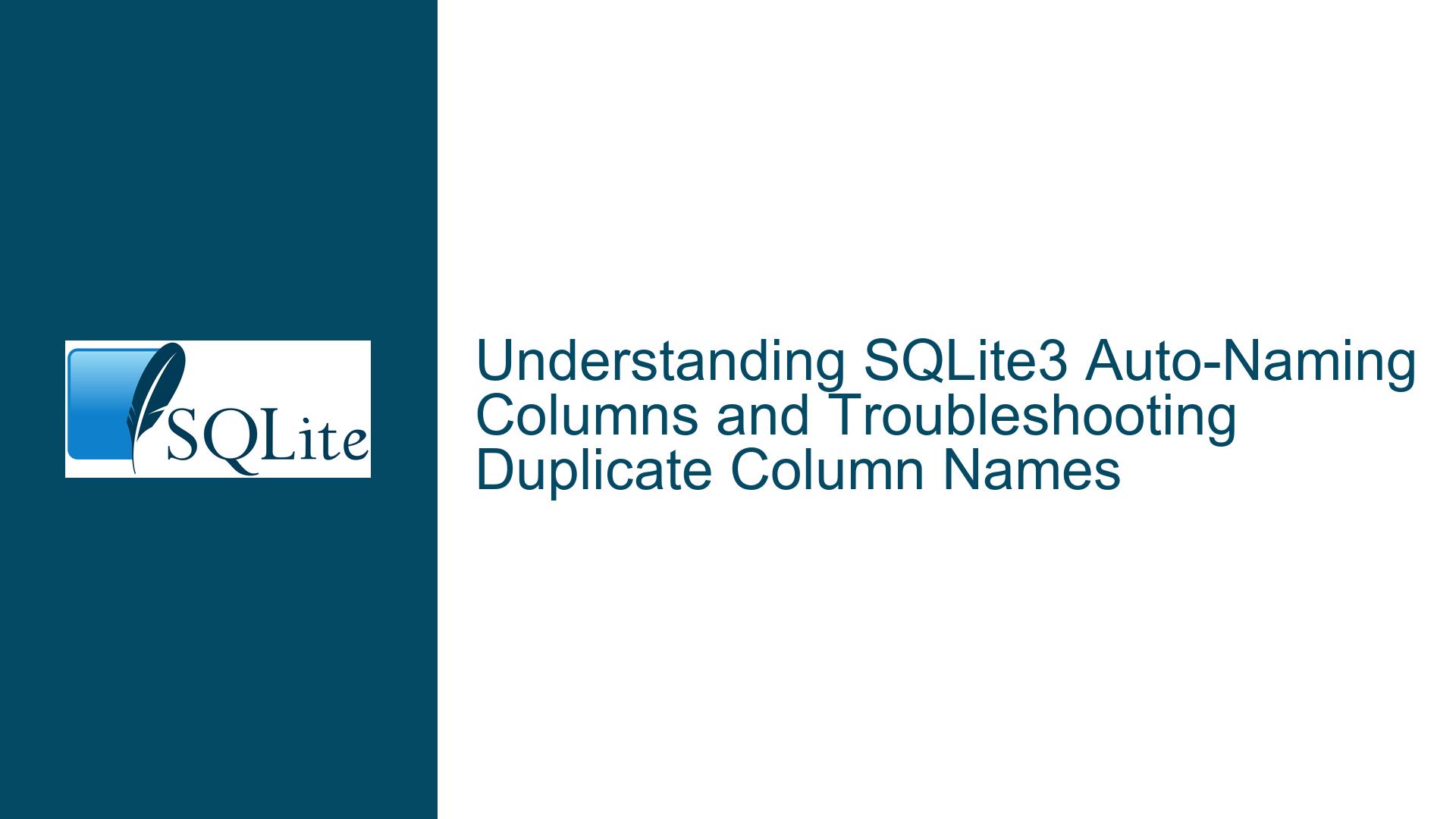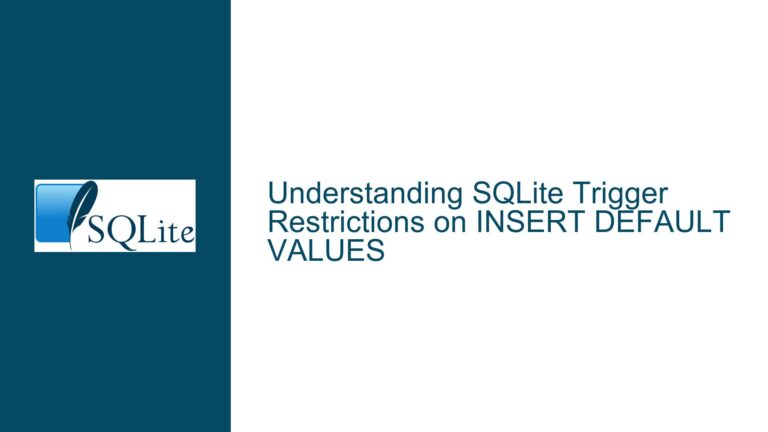SQLite3 Auto-Naming Columns and Troubleshooting Duplicate Column Names
Issue Overview: SQLite3 Auto-Naming Columns and Handling Duplicate Column Names
SQLite3 is a lightweight, serverless, and self-contained database engine that is widely used in applications ranging from embedded systems to web browsers. One of its lesser-documented features is the automatic renaming of columns during data import, particularly when dealing with CSV files that contain duplicate column names. This feature, while convenient, can lead to confusion and unexpected behavior if not properly understood. The core issue revolves around how SQLite3 handles column names during the import process, especially when the input data contains duplicate or "illegitimate" column names.
When importing data into SQLite3, the database engine expects each column to have a unique name. This is a fundamental requirement for relational databases, as column names are used to reference specific fields in queries and operations. However, CSV files, which are commonly used for data import, often contain header rows with duplicate column names. In such cases, SQLite3 employs an auto-naming mechanism to ensure that each column in the resulting table has a unique name. This mechanism is not explicitly documented, and its behavior can vary depending on the version of SQLite3 and the specific circumstances of the import.
The auto-naming feature is designed to handle "illegitimate" column names, which are defined as column names that violate the uniqueness requirement. For example, if a CSV file contains a header row with the names "Name, Age, Age," SQLite3 will automatically rename the second "Age" column to "Age:1" or some other unique identifier. This renaming process is intended to prevent errors and ensure that the data can be successfully imported into a table. However, the exact algorithm used for renaming is not guaranteed to be consistent across different versions of SQLite3, and the feature is subject to change in future releases.
The lack of documentation and the potential for variability in behavior make it challenging for developers to rely on the auto-naming feature for critical applications. While it is generally safe to use for one-off data imports, relying on it for regular data processing or in scenarios where the exact column names are important can lead to issues. For example, if a script or application depends on specific column names, any changes to the auto-naming algorithm could break the script or cause it to behave unexpectedly.
Possible Causes: Why SQLite3 Auto-Naming Occurs and Its Implications
The primary cause of SQLite3’s auto-naming behavior is the presence of duplicate column names in the input data. This is most commonly encountered when importing CSV files, where the header row may contain repeated names. In a relational database, each column in a table must have a unique name to allow for unambiguous referencing in queries. When SQLite3 encounters a CSV file with duplicate column names, it cannot directly create a table with those names, as doing so would violate the uniqueness constraint.
To address this issue, SQLite3 automatically renames the duplicate columns to ensure that each column in the resulting table has a unique name. The exact renaming algorithm is not documented, but it typically involves appending a suffix to the duplicate column names. For example, if a CSV file contains the header "Name, Age, Age," SQLite3 might rename the second "Age" column to "Age:1." This allows the data to be imported without errors, but it also means that the resulting table will have column names that differ from the original CSV header.
Another possible cause of auto-naming is the presence of invalid or unsupported characters in column names. While SQLite3 is generally permissive in terms of the characters allowed in column names, certain characters may be problematic, especially if they are not properly escaped or quoted. In such cases, SQLite3 may automatically rename the columns to avoid potential issues. For example, if a column name contains spaces or special characters, SQLite3 might replace those characters with underscores or other valid characters.
The implications of SQLite3’s auto-naming behavior are significant, particularly for developers who rely on specific column names in their applications. If the auto-naming algorithm changes in a future version of SQLite3, scripts or applications that depend on the exact column names could break. Additionally, the lack of documentation makes it difficult to predict how SQLite3 will rename columns in different scenarios, which can lead to unexpected results.
Furthermore, the auto-naming feature is not intended to be a robust solution for handling poorly formatted CSV files. While it provides a convenient way to import data with duplicate column names, it is not a substitute for proper data cleaning and validation. Developers should be cautious when relying on this feature, especially in scenarios where the exact column names are important.
Troubleshooting Steps, Solutions & Fixes: Managing SQLite3 Auto-Naming and Ensuring Consistent Column Names
To effectively manage SQLite3’s auto-naming behavior and ensure consistent column names, developers can take several steps. These include pre-processing CSV files to remove duplicate column names, using explicit column naming in SQL queries, and leveraging SQLite3’s schema modification capabilities to create more robust tables.
Pre-Processing CSV Files: One of the most effective ways to avoid SQLite3’s auto-naming behavior is to pre-process CSV files before importing them. This involves checking the header row for duplicate column names and renaming them as needed. For example, if a CSV file contains the header "Name, Age, Age," the second "Age" column could be renamed to "Age2" or "Age_2" before importing the data. This ensures that the resulting table will have unique column names that match the original CSV header.
There are several tools and libraries available for pre-processing CSV files, including Python’s pandas library, which provides powerful data manipulation capabilities. By using these tools, developers can automate the process of checking for and renaming duplicate column names, reducing the risk of errors during the import process.
Explicit Column Naming in SQL Queries: Another way to avoid issues with auto-naming is to use explicit column naming in SQL queries. Instead of relying on SELECT * to retrieve all columns from a table, developers should explicitly list the columns they need. This not only avoids potential issues with auto-naming but also makes the query more readable and maintainable.
For example, instead of writing:
SELECT * FROM myTable;
Developers should write:
SELECT Name, Age, Age2 FROM myTable;
This ensures that the query will always return the expected columns, even if the auto-naming behavior changes in a future version of SQLite3.
Leveraging SQLite3’s Schema Modification Capabilities: SQLite3 provides several features for modifying the schema of a table, including the ability to add, rename, and drop columns. Developers can use these features to create more robust tables that are less susceptible to issues with auto-naming. For example, after importing data into a table, developers can use the ALTER TABLE statement to rename columns or add constraints to ensure data integrity.
For example, if a table was created with auto-named columns, developers can use the following SQL statement to rename a column:
ALTER TABLE myTable RENAME COLUMN "Age:1" TO "Age2";
This allows developers to standardize column names and ensure that they match the expected format.
Using the STRICT Table Mode: Starting with SQLite3 version 3.37.0, the STRICT table mode was introduced, which enforces stricter rules for table creation and data insertion. When a table is created in STRICT mode, SQLite3 will enforce data type constraints and reject any attempts to insert invalid data. This can help prevent issues with auto-naming by ensuring that the table schema is well-defined and consistent.
To create a table in STRICT mode, developers can use the following SQL statement:
CREATE TABLE myTable (
Name TEXT,
Age INTEGER,
Age2 INTEGER
) STRICT;
This ensures that the table will only accept data that conforms to the specified schema, reducing the risk of issues with auto-naming.
Customizing the Auto-Naming Algorithm: For developers who need more control over the auto-naming process, it is possible to customize the algorithm used by SQLite3. This requires modifying the SQLite3 source code and recompiling the database engine. The relevant function for auto-naming is zAutoColumn, which can be found in the shell.c file in the SQLite3 source tree.
By modifying this function, developers can implement their own naming conventions or algorithms for handling duplicate column names. However, this approach is only recommended for advanced users who are comfortable working with C code and recompiling SQLite3.
Best Practices for Handling Auto-Naming: To minimize the risk of issues with SQLite3’s auto-naming behavior, developers should follow these best practices:
Avoid Duplicate Column Names: Whenever possible, ensure that CSV files and other data sources do not contain duplicate column names. This can be achieved through pre-processing or by enforcing naming conventions in the data source.
Use Explicit Column Names: Always use explicit column names in SQL queries, rather than relying on
SELECT *. This ensures that the query will return the expected columns, even if the auto-naming behavior changes.Validate Data Before Import: Before importing data into SQLite3, validate the data to ensure that it conforms to the expected schema. This includes checking for duplicate column names, invalid characters, and other potential issues.
Leverage STRICT Table Mode: Use the
STRICTtable mode to enforce stricter rules for table creation and data insertion. This helps ensure that the table schema is well-defined and consistent.Document Auto-Naming Behavior: If auto-naming is used, document the expected behavior and any potential issues that may arise. This helps other developers understand the implications of auto-naming and how to handle it in their code.
By following these steps and best practices, developers can effectively manage SQLite3’s auto-naming behavior and ensure consistent column names in their databases. While the auto-naming feature provides a convenient way to handle duplicate column names, it is important to use it judiciously and be aware of its limitations. With proper planning and validation, developers can avoid issues with auto-naming and create robust, reliable databases that meet their application’s needs.






